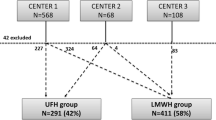Abstract
Background
Recent studies have demonstrated that radiofrequency isolation of the pulmonary veins (PVI) is an effective treatment for symptomatic atrial fibrillation. Based on these positive results, non- pharmacological therapy has been incorporated in the guidelines for drug refractory atrial fibrillation, resulting in an increased popularity. The prevention of thromboembolic complications remains an important issue.
Methods
In January 2010, we adopted an anticoagulation strategy based on continuation of vitamin K antagonists (VKAs) and selective use of transoesophageal echocardiogram (TEE). We retrospectively analysed the results of this strategy in all patients referred for PVI treatment. VKAs were started for all patients 2 months prior to treatment. Discontinuation of oral anticoagulation was considered 3 months after treatment based on thromboembolic and bleeding risk profile. Bleeding and thromboembolic complications were registered during outpatient clinic follow-up up until 3 months.
Results
We performed 151 PVI procedures from January 2010 to March 2011. All patients were seen 6 weeks after discharge. No transient ischaemic accidents or ischaemic cerebrovascular incidents occurred pre-, peri- or postprocedure. Four (2.7%) procedures were complicated by tamponade requiring pericardiocentesis.
Conclusions
Our data support the increasing evidence for continuation of periprocedural administration of VKAs complemented by a selective TEE approach as a safe therapy for thromboembolic complications.
Similar content being viewed by others
References
Haissaguerre M, Jais P, Shah DC, et al. Spontaneous initiation of atrial fibrillation by ectopic beats originating in the pulmonary veins. N Engl J Med. 1998;339:659–66.
Jais P, Cauchemez B, Macle L, et al. Catheter ablation versus antiarrhythmic drugs for atrial fibrillation: the A4 study. Circulation. 2008;118:2498–505.
Cappato R, Calkins H, Chen SA, et al. Updated worldwide survey on the methods, efficacy, and safety of catheter ablation for human atrial fibrillation. Circ Arrhythm Electrophysiol. 2010;3:32–8.
Gopinath D, Lewis WR, Biase LD. Pulmonary vein antrum isolation for atrial fibrillation on therapeutic Coumadin: special considerations. J Cardiovasc Electrophysiol. 2011;22:236–9.
Nazeri A, Rasekh A, Massumi A, et al. Coalescence of splines on a basket mapping catheter during ablation using a closed-loop irrigation catheter. Europace. 2009;11:258–9.
Demolin JM, Eick OJ, Munch K, et al. Soft thrombus formation in radiofrequency catheter ablation. Pacing Clin Electrophysiol. 2002;25:1219–22.
Oral H, Chugh A, Ozaydin M, et al. Risk of thromboembolic events after percutaneous left atrial radiofrequency ablation of atrial fibrillation. Circulation. 2006;114:759–65.
Camm AJ, Kirchhof P, Lip GY, et al. Guidelines for the management of atrial fibrillation: the task force for the management of atrial fibrillation of the European Society of Cardiology (ESC). Eur Heart J. 2010;31:2369–429.
Muller A, Scharner W, Borchardt T, et al. Reliability of an external loop recorder for automatic recognition and transtelephonic ECG transmission of atrial fibrillation. J Telemed Telecare. 2009;15:391–6.
Calkins H, Brugada J, Packer DL, et al. HRS/EHRA/ECAS expert consensus statement on catheter and surgical ablation of atrial fibrillation: recommendations for personnel, policy, procedures and follow-up. A report of the Heart Rhythm Society (HRS) task force on catheter and surgical ablation of atrial fibrillation. Hear Rhythm. 2007;4:816–61.
Calvo N, Mont L, Vidal B, et al. Usefulness of transoesophageal echocardiography before circumferential pulmonary vein ablation in patients with atrial fibrillation: is it really mandatory? Europace. 2011;13:486–91.
Puwanant S, Varr BC, Shrestha K, et al. Role of the CHADS2 score in the evaluation of thromboembolic risk in patients with atrial fibrillation undergoing transesophageal echocardiography before pulmonary vein isolation. J Am Coll Cardiol. 2009;54:2032–9.
Grip L, Blomback M, Schulman S. Hypercoagulable state and thromboembolism following warfarin withdrawal in post-myocardial-infarction patients. Eur Heart J. 1991;12:1225–33.
Gaita F, Caponi D, Pianelli M, et al. Radiofrequency catheter ablation of atrial fibrillation: a cause of silent thromboembolism? Magnetic resonance imaging assessment of cerebral thromboembolism in patients undergoing ablation of atrial fibrillation. Circulation. 2010;122:1667–73.
Author information
Authors and Affiliations
Corresponding author
Rights and permissions
About this article
Cite this article
Oude Velthuis, B., Stevenhagen, J., van Opstal, J.M. et al. Continuation of vitamin K antagonists as acceptable anticoagulation regimen in patients undergoing pulmonary vein isolation. Neth Heart J 20, 12–15 (2012). https://doi.org/10.1007/s12471-011-0223-0
Published:
Issue Date:
DOI: https://doi.org/10.1007/s12471-011-0223-0




